Eight out of ten people will experience back pain at some point in their lives, often due to a bulging disc. This common condition leads many to seek exercises that can offer relief without the need for invasive procedures. Understanding the delicate interplay between the spinal discs and the muscles that support them is crucial for those looking to address back pain effectively.
Behind every bulging disc is a story of spinal health, posture, and the intricate anatomy of the lumbar region. It’s a tale of how a small, jelly-like cushion between the bones in your spine can impact your entire well-being. Incorporating targeted exercises can help alleviate the discomfort associated with a problematic disc.
The journey toward a pain-free back is paved with simple, yet powerful exercises designed to ease the strain on the lumbar spine. In the following article, we explore the top 9 exercises that have helped countless individuals regain control over their back pain, delve into the significance of good posture, and highlight the role of physical therapy and core strengthening in supporting a resilient spine.
1. Spinal Decompression Hanging
If you’re grappling with back pain due to a bulging disc, spinal decompression hanging might be a gentle yet effective exercise to add to your routine.
This form of physical activity specifically targets the relief of pressure on the discs by increasing the space between individual vertebrae in the spinal column. It’s a straightforward method that involves suspending from a bar, allowing gravity to aid in easing disc discomfort.
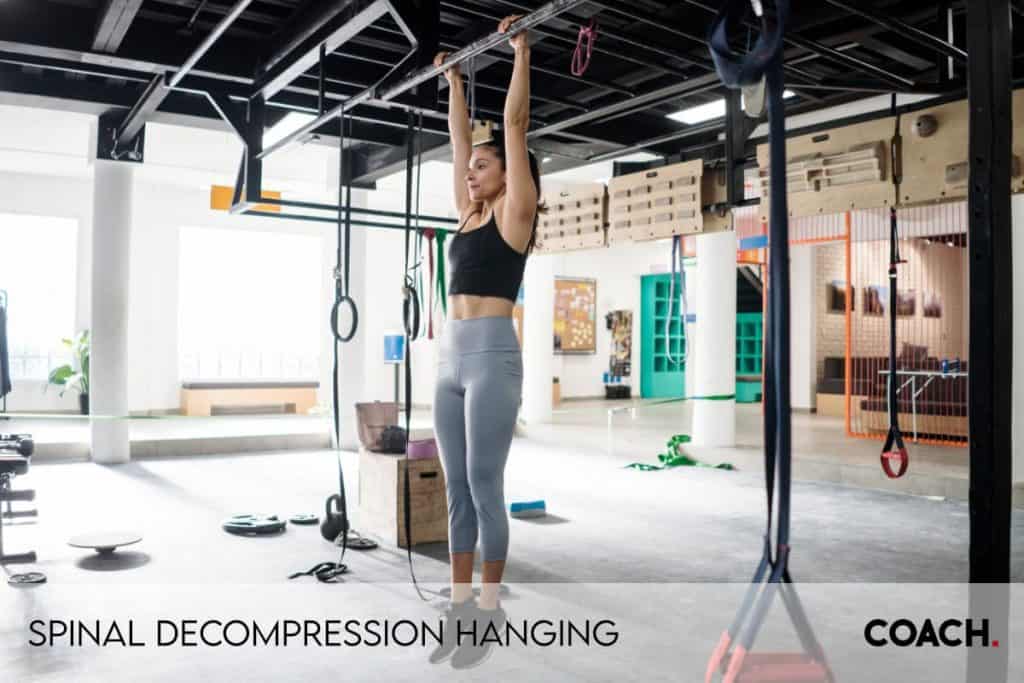
How to perform the Spinal Decompression Hanging exercise
- Find a stable overhead bar or pull-up bar.
- Grip the bar with both hands, ensuring a secure hold.
- Gradually lift your feet off the ground, allowing your body to suspend freely.
- Hang from the bar for a duration that allows your spine to stretch without causing pain.
- It is recommended to start with 30 seconds per hang.
- Repeat this exercise for a total of three repetitions.
Not only can this daily activity bolster the health of your spinal discs, but it may also prove beneficial for overall mobility.
Keep in mind that safety and proper technique are paramount. There should be no pain experienced during the hanging process. If discomfort arises, discontinue immediately and consult with a physical therapist to assess your technique and exercise programme. Remember, the key is a slow and controlled descent, ensuring a safe release from the bar.
2. Cobra Pose
For those experiencing a bulging disc, integrating gentle exercises such as the Full Cobra Pose into your routine can be highly beneficial.
This yoga-inspired movement targets the lumbar spine and promotes the repositioning of the disc’s nucleus pulposus by encouraging it to shift toward the centre. It is especially helpful for alleviating discomfort in the lower back caused by herniated discs.
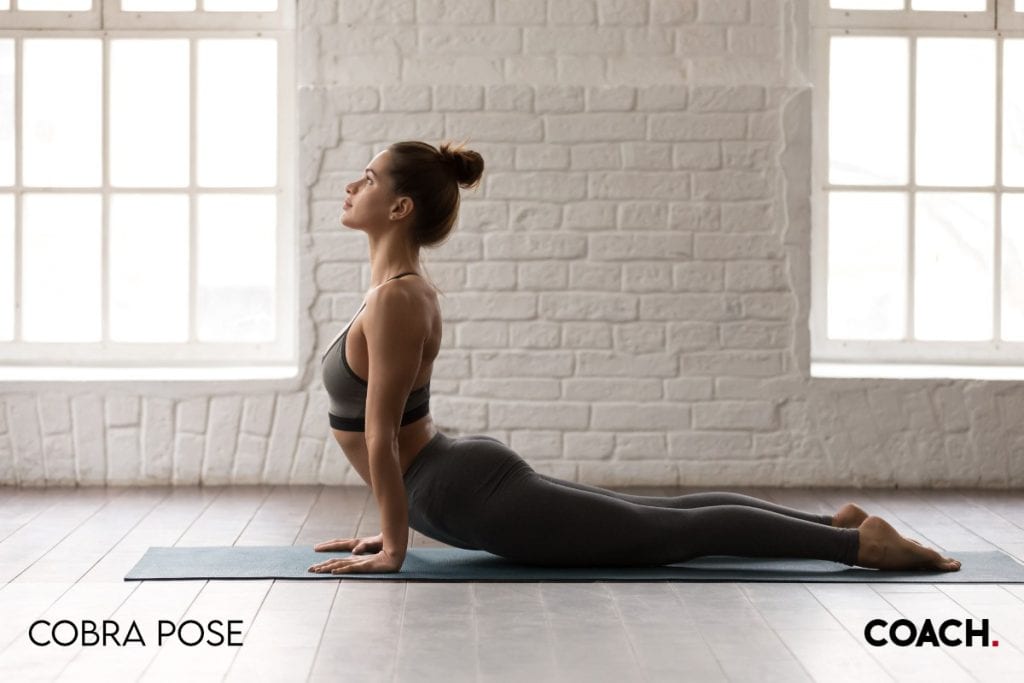
How to perform a Cobra Pose
- Start by lying flat on your stomach with your pelvis grounded on the floor.
- Place your hands on the ground directly under your shoulders.
- Slowly straighten your arms, lifting your chest and upper body off the floor.
- Keep your lower back relaxed throughout the movement.
- As you raise your chest, feel the stretch in your spine and the opening of the space between your intervertebral discs.
- Hold this position for a few seconds, focusing on a deep breath in and out.
- Gently lower your chest and upper body back down to the starting position.
- Repeat this exercise for a desired number of repetitions, according to your comfort level.
Maintain the pose for 10-15 seconds to allow the disc to adjust adequately, and then slowly lower yourself back down. Repeating this pose 10 times can maximise its restorative effects on the spinal column, potentially reducing neck pain and poor posture. The extended time in the pose creates a more significant spinal extension than its counterpart, the Half Cobra Pose, offering additional support in realigning the disc and mitigating pain.
3. Cat-Cow Stretch
The Cat-Cow Stretch is renowned for its effectiveness in managing herniated disc discomfort. By expanding the intervertebral disc space, it alleviates added pressure on the disc itself.

How to perform a Cat-Cow Stretch
- Start in a neutral, tabletop position on your hands and knees.
- Sync your movements with your breath.
- Inhale deeply, allowing your stomach to relax towards the ground and lift your gaze up towards the ceiling.
- Exhale and round out your spine, tucking your chin to your chest like a cat stretching.
- Repeat this sequence for about 10 repetitions per set.
- Aim to do 2-3 sets of the Cat-Cow Stretch for optimal benefits.
Not only does the Cat-Cow Stretch assist in relieving pain from disc herniations, but it also promotes spinal mobility and aids in improving overall back function.
Benefits of the Cat-Cow Stretch:
- Opens the spaces between vertebrae
- Reduces pressure on the herniated disc
- Enhances spinal flexibility and health
Incorporating this exercise into your routine can be a valuable component of a broader exercise programme aimed at strengthening the back and alleviating discomfort associated with herniated discs. As always, consult with a physical therapy professional before beginning any new exercise regimen, particularly if you’re experiencing severe back pain or have spine-related concerns.
4. Pelvic Tilts
Pelvic tilts are a gentle exercise specifically designed to target and strengthen core muscles, including the abdomen, hips, and lower back. They are particularly useful for individuals experiencing discomfort from bulging discs.
By performing this low-impact exercise, you can help to stabilise the lumbar spine and alleviate pressure on the spinal column.
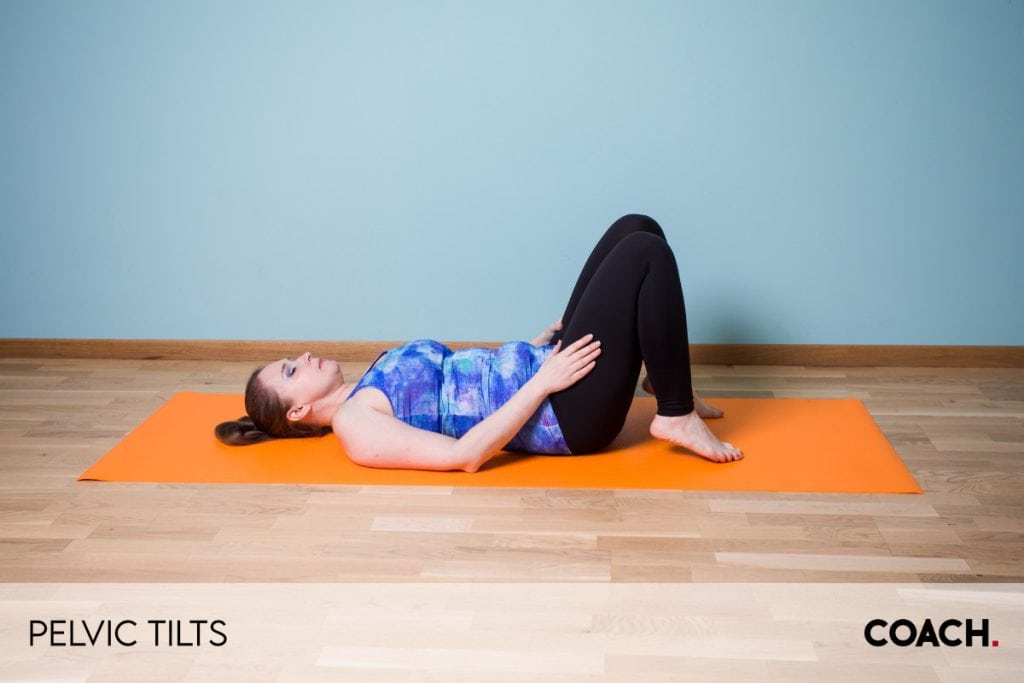
How to perform a Pelvic Tilt:
- Begin in the starting position by lying on your back with knees bent and feet planted firmly on the ground.
- Keep your feet at hip-width apart, and allow your arms to rest naturally by your sides.
- Engage your abdominal muscles by pulling your belly button in towards the spine, aiming to flatten the back against the floor.
- Slowly tilt your pelvis up towards the ceiling while maintaining a neutral spine position.
- Aim to hold the tilt for 10-15 seconds, ensuring to breathe evenly throughout the movement.
- Return to the initial neutral position and repeat the exercise.
This exercise offers a safe way to engage and strengthen core muscles without adding extra strain. By incorporating pelvic tilts into your daily activities or exercise programme, you may improve poor posture, enhance muscle strength, and support the health of your spinal column.
5. Bridging
Bridging is a standout exercise that targets core stability, vital for those coping with bulging discs. It’s a low-impact move, strengthening without straining the spine.
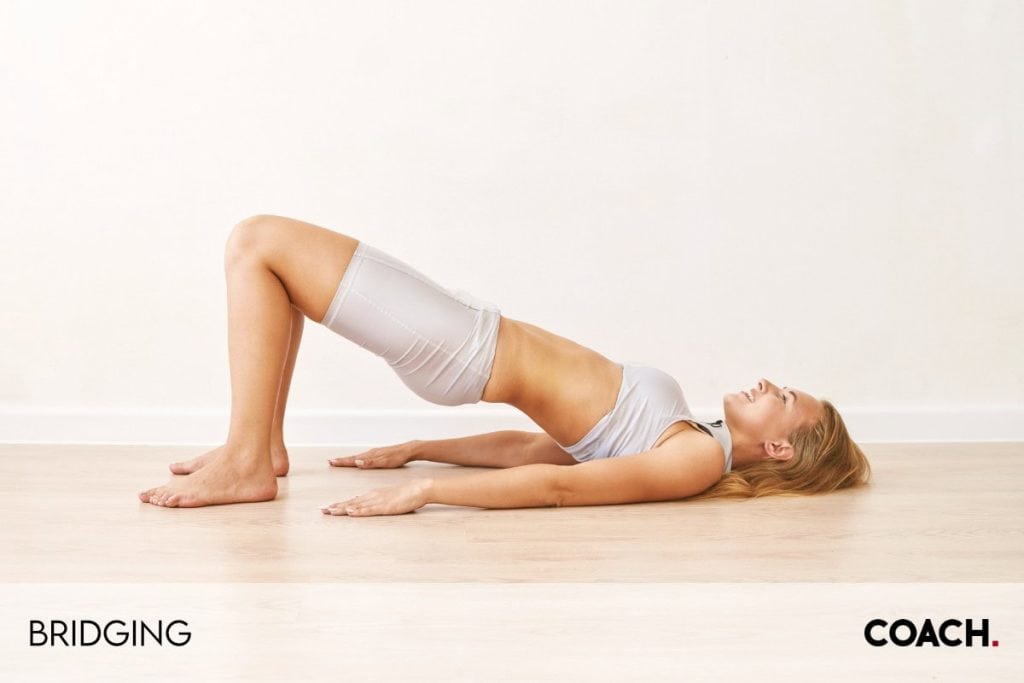
How to perform the Bridging exercise
- Lie flat with knees bent and feet flat, arms by your side. Ensure your spine is in a neutral position to avoid poor posture.
- Engage your core muscles gently.
- Lift your hips off the floor, aiming to create a straight line from knees to shoulders.
- Hold the bridge for 15-20 seconds, maintaining even breathing.
- Slowly lower your hips back to the starting position.
- Perform 10-15 reps, building up hold time as strength improves.
By reinforcing the support around the lumbar spine, bridging aids in alleviating pain and expediting recovery. It prevents the need for strenuous exercise that could exacerbate a bulging disc. Instead, bridging focuses on solidarity and fortitude within the spinal and abdominal regions, crucial for daily activities. Moreover, progressing from a 10 to a 15-second hold underlines a gradual increase in endurance, pivotal for continuous improvement.
6. Knee-to-Chest Stretch
The Knee-to-Chest Stretch is a therapeutic exercise aimed at alleviating discomfort associated with a bulging disc. This gentle exercise focuses on the lumbar spine and can help improve mobility while stretching the lower back muscles.

How to perform a Knee-to-Chest Stretch
- Lie flat on your back on a comfortable surface.
- Keep both legs extended and your spinal column aligned in a neutral position.
- Slowly lift your right leg, bending the knee toward your chest.
- Clasp both hands around the right knee to aid the stretch.
- Gently pull the knee closer to your chest, ensuring you maintain proper posture without strain.
- Hold this position for 10-15 seconds, feeling a mild stretch without any pain.
- Gradually return to the starting position and then repeat the stretch with the left leg.
Important Tips
- Perform the stretch in a slow and controlled manner.
- Breathe regularly throughout the exercise.
- Aim for several repetitions on each side, as comfort allows.
This stretch helps improve flexibility in daily activities and can play an essential role in a larger exercise programme designed for those experiencing disc herniations or general muscle weakness in the glutaeal and hamstring muscles. Always consult with a physical therapy professional before starting new exercises, especially if you have had prior spine issues or neck pain.
7. Prone Leg Lifts
Prone Leg Lifts are a valuable addition to strengthening routines, particularly for those dealing with lower back issues like a bulging disc. This gentle exercise targets the muscles that support the lumbar spine, enhancing core stability – an essential factor in spinal health and recovery from disc-related discomfort.

How to perform Prone Leg Lifts
- Start by lying flat on your stomach, with your face down and body in a straight, neutral position.
- Slowly lift one leg off the floor, keeping it straight.
- Hold the lifted leg in the air for 2-3 seconds.
- Gently lower the leg back down to the starting position.
- Alternate between legs, lifting and lowering each leg in a controlled motion.
- Aim for several repetitions on each leg, as comfort allows, to ensure balanced muscle engagement.
It’s important to keep the movements controlled and avoid any jerking motions that could exacerbate existing conditions. Initially, try a few repetitions and gradually increase as your strength and endurance improve. This simple activity not only promotes lower back strength but also contributes to overall physical activity levels, crucial for maintaining daily activities without pain.
Remember to keep your head and spine aligned during the exercise and consult with a physical therapy professional if you’re uncertain about your form, especially if you’re recovering from disc herniations.
8. Wall Sits
Wall sits are an excellent exercise for those managing a bulging disc. These simple and effective movements focus on reinforcing core stability and improving your overall posture, both crucial when targeting spinal column health.
By engaging the lumbar spine in the correct alignment, wall sits can provide the foundational support needed for daily activities.
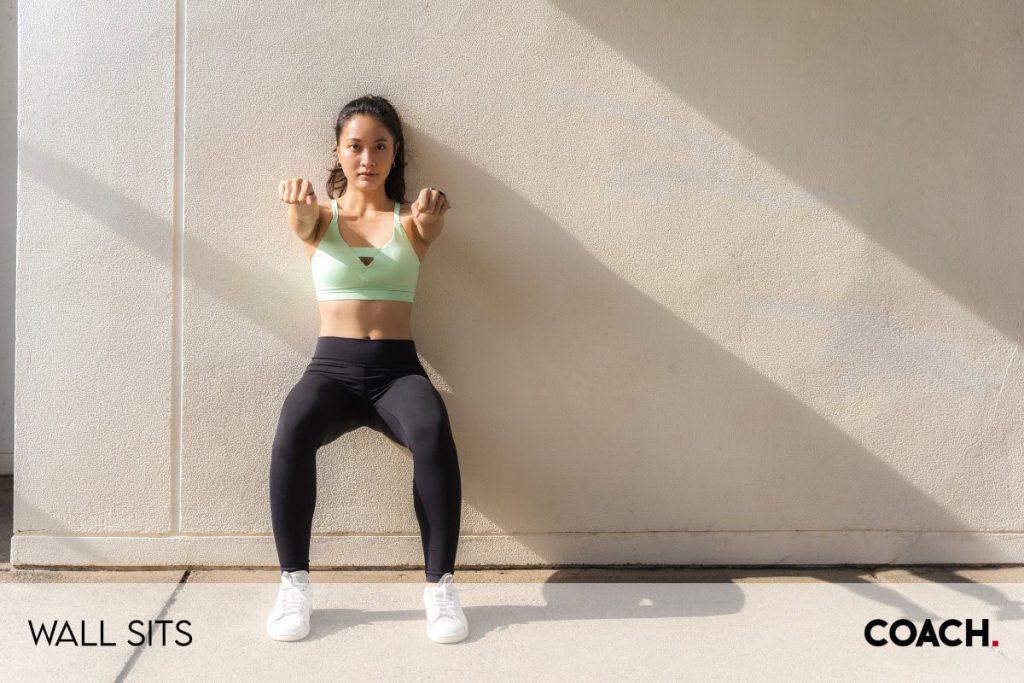
How to perform a Wall Sit
- Stand with your back against a wall, feet shoulder-width apart.
- Slide down the wall until your knees are at a 90-degree angle, ensuring your back is flat against the wall.
- Maintain this ‘seated’ position, keeping your abdominal muscles engaged and your spine in a neutral position. Aim to hold this for 10-15 seconds initially.
- Gradually increase the time as your strength improves, being careful not to engage in strenuous exercise that could exacerbate disc herniations.
Performing wall sits regularly helps to strengthen not only the hamstrings and glutaeal muscles but also fortifies the core, a cluster of muscles comprising the stomach and back.
By boosting core strength, wall sits aid in mitigating the muscle weakness often associated with bulging discs, thereby alleviating associated neck and back pain. Engaging in this gentle yet powerful exercise brings a marked improvement in spine stability and can be an integral part of a physical therapy programme aimed at addressing bulging disc issues.
9. Partial Crunches
Partial crunches are an essential exercise for those with a lumbar herniated disc, targeting the strengthening of back and stomach muscles. As a gentle exercise that forms a core part of treatment plans, they aid in pain reduction and support recovery.
Prior to beginning partial crunches, warm-ups are crucial. This prepares the body, particularly the lumbar spine area, for the activity ahead, reducing the risk of strain or increased pain. The warm-up routine should focus on getting the spinal column and surrounding muscles ready for physical activity.
When performing partial crunches, one must maintain a starting position with knees bent to ensure the lower back, and intervertebral disc space is not unduly stressed. Here is how to perform them safely and effectively:
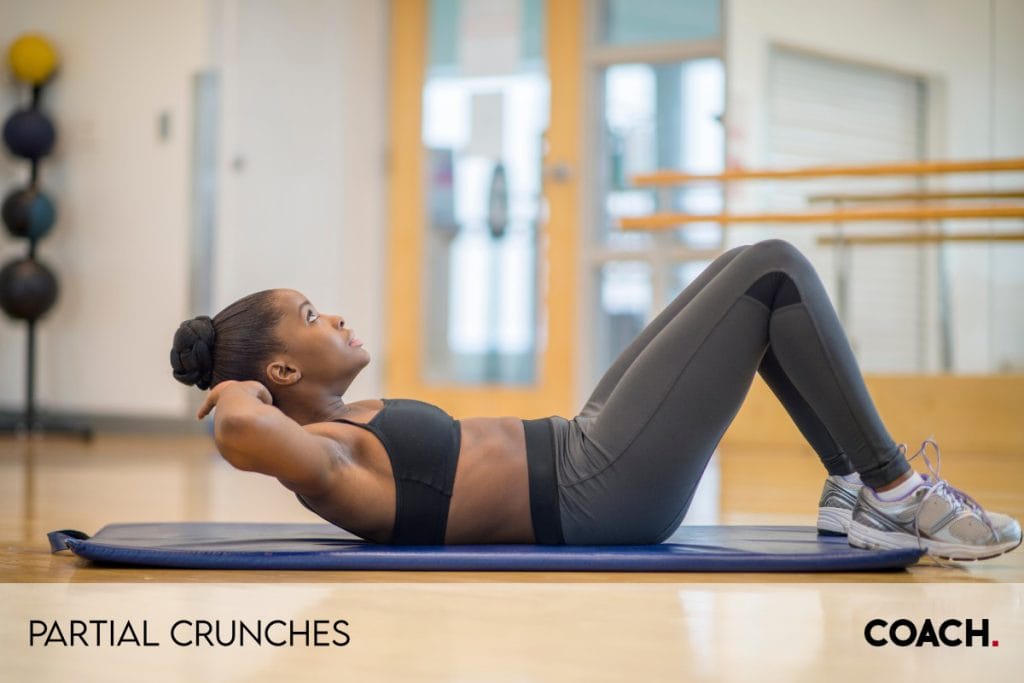
How to do Partial Crunches
- Lie flat on your back, knees bent, feet flat, and hands behind your head.
- Gently tighten your stomach muscles.
- Lift your shoulders off the floor slightly, hold for 2-3 seconds, then ease back down.
Practising this exercise regularly can lead to increased core strength, supporting daily activities and reducing muscle weakness. Remember to hold each crunch for only a few seconds to avoid unnecessary tension and to maintain a neutral spine throughout the movement for maximum benefit.
Lumbar Spine and Spinal Column
Recovery from a herniated disc often hinges on a tailored exercise programme aimed at fortifying the muscles that lend support to the spine. By emphasising back and hamstring strength, one can lessen the mechanical demand on the spinal column, alleviating discomfort and expediting healing through improved blood circulation.
In the realm of less strenuous exercise, many find solace and improvement in the gentle postures of yoga, the buoyant exercise of swimming, the rhythmic motion of walking, or the low impact of cycling. These activities not only invigorate spinal flexibility but also mitigate the chances of a disc herniation recurring.
Understanding the Anatomy of the Lumbar Spine and Spinal Column
The lumbar spine, the lower segment of the spinal column, is composed of five intrinsically sturdy vertebrae, designated from L1 to L5. This segment bears the weight of the upper body and bestows the lower back with a range of motions. Sandwiched between these vertebrae are intervertebral discs, which serve as the spine’s shock absorbers—furnishing flexibility and a cushioning effect during bodily movements. However, when the robust exterior of a disc weakens, it can lead to a bulging disc, characterised by the disc’s protrusion into the intervertebral disc space, disrupting the spine’s harmony.
Understanding the intricate architecture of the lumbar spine is a cornerstone for devising exercise routines that aim to alleviate pressure and nurture recovery from bulging or herniated discs.
How a Bulging Disc Can Affect the Lumbar Spine
When the constitution of a bulging disc falters, leading it to swell sideways into the spinal canal, it can result in nerve compression, muscle weakness, diminished mobility, and altered reflex responses—symptoms often materialising in the lower back, buttocks, legs, and feet. The repercussions of a bulging disc are not limited to physical discomfort but can also hamper daily activities and impede one’s ability to participate in regular physical activity.
To counteract these effects, exercises designed for individuals with a bulging disc aim to bolster back muscle resilience, escalate spinal stability, and alleviate stress on the impacted disc. These exercises stand as integral components of an overarching strategy to manage bulging disc symptoms and improve spinal health.
Engaging in bulging disc exercises can offer a proactive approach to managing the delicate balance of the spinal column. It is essential to choose exercises that accommodate an individual’s specific condition and to progress gradually to avoid exacerbating existing issues.
Poor Posture and Its Impact on Bulging Disc
Poor posture significantly contributes to the development and exacerbation of bulging discs, particularly in the lumbar spine. Whether it is due to hunching over a desk or repeated spinal flexion, such postures push the disc out of its neutral alignment.
Poor posture can negatively affect the spinal posture and flexibility of white-collar workers, and chronic poor posture may be linked to chronic nonspecific low back pain [1].
Du SH, Zhang YH, Yang QH, Wang YC, Fang Y, Wang XQ. Spinal posture assessment and low back pain.
When the spine is continuously held in poor posture, added strain forces the outer core of the disc to weaken, leading to a bulging effect where the inner core encroaches upon the spinal canal. This can greatly restrict the spine’s natural range of motion and flexibility, causing pain and possibly affecting nerve functionality.
Stationary cycling is often a go-to exercise recommendation for those suffering from a bulging disc. This activity strengthens the lower body while minimising stress on the spinal column. Additionally, restorative exercises from yoga, Pilates, and Tai Chi promote gentle movement, balance, and posture-awareness, all of which are vital in the management of bulging disc symptoms. For direct posture improvement, exercises such as wall sits and shoulder blade squeezes target specific muscle groups to fortify and align both lower and upper back muscles.
Tips for improving posture to alleviate back pain
Addressing back pain linked to a bulging disc can start with improving posture through specific exercises and stretches. Scapular setting stretches, for example, are designed to reinforce the importance of posture and ease the pressure on discs, thereby reducing back pain. Postural exercises such as wall sits and shoulder blade squeezes focus on strengthening supportive muscle groups to correct posture imbalances.
Furthermore, practises like Pilates and Tai Chi contribute to spinal alignment and flexibility. By promoting body awareness, these disciplines help individuals achieve and maintain proper posture. Strengthening the core and leg muscles is also vital in reducing the load on the spinal column, thus alleviating back discomfort.
It’s crucial to avoid intense neck flexion and other movements that can increase pressure on a bulging disc, especially in the cervical region. Maintaining an optimal posture throughout all daily activities can go a long way in preventing and reducing existing back pain.
Physical Therapy for Bulging Disc
Physical therapy is a cornerstone in the management of bulging discs, offering a structured approach to restore function, enhance stability, and alleviate pain. By focusing on exercises that build the strength of the back muscles and improve spine stability, physical therapy significantly reduces the stress placed on the intervertebral disc space. Specific routines are designed not only to address existing discomfort but to fortify the back against future episodes of herniated discs.
Engaging in a personalised exercise programme under the supervision of a licenced physical therapist ensures that movements are carried out safely, minimising the risk of further injury and optimising recovery.
Understanding the role of physical therapy in treating bulging disc
Doctors often suggest physical therapy as a primary intervention for symptomatic relief of a bulging disc. The aim of such therapeutic exercises is to promote flexibility and stability around the area of disc herniation.
Through physical therapy, patients can improve their overall endurance and circulation, facilitating the body’s natural healing process. The methodical use of stretches and strength-training exercises tailored to individual needs helps to alleviate the distressing symptoms associated with a bulging disc. Recognising the effectiveness of physical therapy in this regard underscores the importance of consulting a healthcare provider before beginning any regimen, ensuring proper technique and progression of exercises.
Common physical therapy techniques for bulging disc relief
A regimented physical therapy programme for bulging disc relief incorporates various techniques that centre on strengthening and stabilising the lumbar spine. Among these, pelvic tilt exercises are fundamental for activating and fortifying the core muscles, providing much-needed support for the lower back. The pelvic bridge exercise further assists by targeting the glutaeal and hamstring muscles, contributing to spinal stability and thus, mitigating the stress on the bulging disc. Additionally, the bird dog is a balanced exercise that engages the abdominal muscles and lower back, enhancing core strength and aiding spinal stability.
Static exercises such as heel taps also play a role in safely strengthening the core with minimal risk of exacerbating symptoms. By allowing the individual vertebrae to remain in a neutral alignment, these exercises maintain spinal integrity while building muscle support. Given the sensitivity of a herniated disc condition, avoiding strenuous exercises like toe touches and sit-ups is crucial, as they can place excessive pressure on the lower back. Instead, the aim of chosen exercises is to increase core strength, maintain spine stability, and gently stretch the supportive tissues, all while observing the appropriate neutral positions and movement patterns.
By adhering to these physical therapy techniques, individuals with a bulging disc can experience significant symptom relief and a gradual return to daily activities with improved capacity and less discomfort.
Core Strengthening for Bulging Disc
Core strength is fundamental when addressing the stability and health of the spinal column, particularly for those experiencing a bulging disc. By maintaining and enhancing core muscular support, individuals can achieve a noteworthy balance between strength and flexibility. This equilibrium is not only essential for the prevention of new injuries but also serves as a supportive framework for those with existing bulging discs.
Core strength allows for more efficient movement and a broader range of motion, enabling the body to perform daily activities more effectively and with decreased risk of further disc injury. For those dealing with bulging discs, core exercises can meaningfully reduce symptom intensity and improve overall back health.
The important of core strength for bulging disc relief
When a bulging disc afflicts the spine, the power of core strength becomes increasingly apparent. It is the strong, yet flexible muscles surrounding the spine that provide stability and aid in the essential task of pressure reduction on the discs.
Engaging the abdominal, oblique, and lower back muscles through targeted strength-building exercises enhances spinal support, greatly benefiting individuals with bulging disc discomfort. This support system is vital; it absorbs and distributes forces that would otherwise fall solely on the spinal discs. For optimum back management, maintaining proper form during these exercises is imperative, ensuring that maximum benefits are reaped, aiding in symptom relief and facilitating a more resilient and adaptable spine.
References/Further Reading
[1] Du SH, Zhang YH, Yang QH, Wang YC, Fang Y, Wang XQ. Spinal posture assessment and low back pain. EFORT Open Rev. 2023;8(9):708-718. Published 2023 Sep 1. doi:10.1530/EOR-23-0025